Life and Letters in the Ancient Mediterranean
Ovid
Ovid at the University of Missouri
Ovid was one of the most important, and controversial, of the Roman poets. Writing towards the end of the Golden Age of Latin literature under the emperor Augustus, Ovid won great popularity and acclaim. For reasons still obscure, however, he fell foul of the Augustan regime and was exiled from Rome to Tomis, a provincial backwater on the Black Sea.
Ovid’s most famous work was the Metamorphoses, the central theme of which is changes of shape: the nymph Daphne changing into a tree; the boy Narcissus into a flower; the god Zeus (on several occasions) into a bull. Ovid uses this unifying theme to bring together all the best-known tales from Greek and Roman myth, weaving them together into a continuous narrative.
Owing to the abundance and variety of the myths recounted in the Metamorphoses, the poem has always leant itself to illustration. Countless illustrated editions have been produced over the centuries, some with artwork specially commissioned from famous artists, others recycling the illustrations of previous editions.
The Special Collections & Rare Books Department at the University of Missouri has an extensive collection of editions of Ovid’s works, and of illustrated editions of the Metamorphoses in particular.
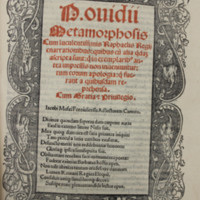
Ovid (43 BCE – 17 or 18 CE)
P. Ovidii Metamorphosis.
Venetiis: Georgius de Rusconibus Mediolanensis, 1517.
Vault PA6519 .F2 1520A
This early edition of Ovid's Metamorphoses features a series of popular woodcuts that is found in several editions from this period. The printer, Giorgio Rusconi, although Milanese in origin, was active mainly in Venice, where he specialized in works by classical authors. This copy is bound with a 1520 edition of Ovid's Fasti.
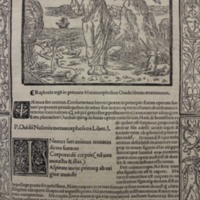
Ovid (43 BCE – 17 or 18 CE)
P. Ovidii Metamorphosis.
Venetiis: Opera & imprensa I. Tacuini, 1520.
Vault PA6519 .F2 1520A
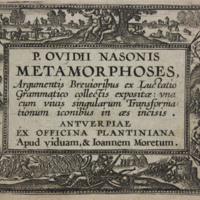
Ovid (43 BCE – 17 or 18 CE)
Ovidii Nasonis Metamorphoses Argumentis Brevioribus ex Luctatio Grammatico Collectis Expositæ.
Antverpiae [Antwerp]: Ex Officina Plantiniana apud viduam & J. Moretum, [1591].
Rare PA6531 .L3 1591
Summaries of and selections from the works of classical authors were popular in the Middle Ages and continued to be produced after the development of printing. This example, published by the famous Plantin-Moretus printing house, combines summaries of all the stories from the Metamorphoses with engravings of each story. Luctatius Grammaticus, the author of the summaries, is sometimes identified with Lactantius Placidus. At least some of the illustrations were produced by the Flemish draughtsman and engraver Pieter van der Borcht.
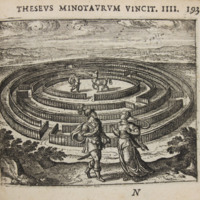
Ovid (43 BCE – 17 or 18 CE)
Ovidii Nasonis Metamorphoses Argumentis Brevioribus ex Luctatio Grammatico Collectis Expositæ.
Antverpiae [Antwerp]: Ex Officina Plantiniana apud viduam & J. Moretum, [1591].
Rare PA6531 .L3 1591
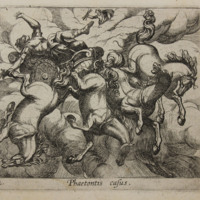
Antonio Tempesta (1555-1630)
Metamorphoseon sive transformationum ovidianarum libri quindecim.
Amsterodami: W. Ianssonius, [1606?].
Rare NE662 .T4 A37
Antonio Tempesta was a versatile artist whose output included paintings, etchings, and tapestry designs. It is for his etchings, however, that he is best known, most of which were produced in series based on biblical or classical themes. This series brings together 150 stories from Ovid's Metamorphoses, identified by captions but otherwise without accompanying text. Tempesta worked extensively in his native Italy, but was also well conntected in Flemish artistic circles.

Antonio Tempesta (1555-1630)
Metamorphoseon sive transformationum ovidianarum libri quindecim.
Amsterodami: W. Ianssonius, [1606?].
Rare NE662 .T4 A37
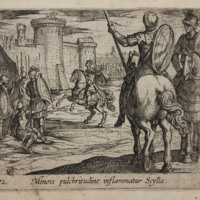
Antonio Tempesta (1555-1630)
Metamorphoseon sive transformationum ovidianarum libri quindecim.
Amsterodami: W. Ianssonius, [1606?].
Rare NE662 .T4 A37
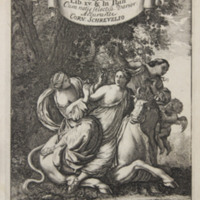
Ovid (43 BCE – 17 or 18 CE)
Pvb. Ovidii Nasonis Opera Omnia.
Lvgdvni Batavorvm [Leiden]: Ex Officina Petri Leffen, 1661.
Rare PA6519 .A2 1662
While a printer could commission an original set of illustrations for a new edition of Ovid, it was cheaper and easier to use copies of existing ones. The engravings in this Dutch edition of Ovid's works are found in a wide variety of editions form the 17th and 18th centuries. They reappear, for example, in the 1724 edition of Ovid's Metamorphoses published by Samuel Palmer, which is also featured in this exhibit.
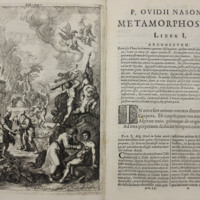
Ovid (43 BCE – 17 or 18 CE)
Pvb. Ovidii Nasonis Opera Omnia.
Lvgdvni Batavorvm [Leiden]: Ex Officina Petri Leffen, 1661.
Rare PA6519 .A2 1662
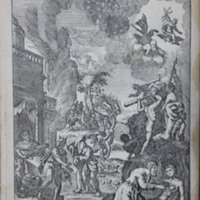
Ovid (43 BCE – 17 or 18 CE)
Ovid’s Metamorphoses in Fifteen Books.
London: Printed by S. Palmer, 1724.
Rare PA6522 .M2 1724
The illustrations used in this edition of Ovid's Metamorphoses are almost identical to those used in the 1661 edition of Ovid's works printed by Petrus Leffen, which is also featured in this exhibit. The quality of the engraving in the earlier work is, however, much higher. Samuel Palmer was one of the most successful English printers of the first quarter of the 18th century, though his business evetually ran into difficulties. He briefly employed a young Benjamin Franklin, and also wrote a significant history of printing.
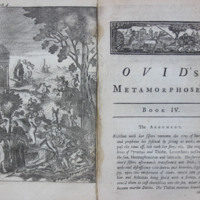
Ovid (43 BCE – 17 or 18 CE)
Ovid’s Metamorphoses in Fifteen Books.
London: Printed by S. Palmer, 1724.
Rare PA6522 .M2 1724

Ovid (43 BCE – 17 or 18 CE)
Les métamorphoses d'Ovide.
Amsterdam: R. & J. Wetsein & G. Smith, 1732.
Vault PA6523 .M2 1732
This deluxe edition of the Metamorphoses contains both Ovid's Latin text and the French translation of the abbé Banier. Also included are Baniers interpretations of the stories found in Ovid. Banier approached Greek and Roman myth from a rationalizing point of view and frequently adopted euhemerist explanations of myth, arguing that mythical stories have their origins in real events that have been exaggerated and distorted over time. The engravings for this edition were provided by Bernard Picart and are of the highest quality. Picart is best known, however, for a series of over 250 prints recording the religious practices of the entire world.

